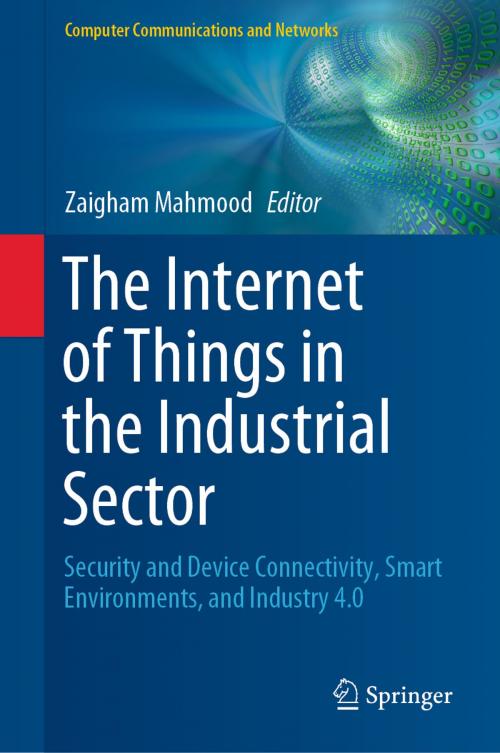The Internet of Things in the Industrial Sector
Security and Device Connectivity, Smart Environments, and Industry 4.0
Nonfiction, Computers, Networking & Communications, Hardware, Science & Nature, Technology, Telecommunications, General Computing| Author: | ISBN: | 9783030248925 | |
| Publisher: | Springer International Publishing | Publication: | August 2, 2019 |
| Imprint: | Springer | Language: | English |
| Author: | |
| ISBN: | 9783030248925 |
| Publisher: | Springer International Publishing |
| Publication: | August 2, 2019 |
| Imprint: | Springer |
| Language: | English |
This book has a focus on the development and deployment of the Industrial Internet of Things (IIoT) paradigm, discussing frameworks, methodologies, benefits and limitations, as well as providing case studies of employing the IoT vision in the industrial domain. IIoT is becoming an attractive business reality for many organisations such as manufacturing, logistics, oil and gas, energy and other utilities, mining, aviation, and many more. The opportunities for this paradigm are huge, and according to one report, the IIoT market is predicted to reach $125 billion by 2021. The driving philosophy behind the IIoT is that smart machines are better than humans at accurately capturing, analysing and communicating real-time data. The underlying technologies include distributed computing, machine learning, artificial intelligence, and machine-to-machine communication, with a typical IIoT system consisting of intelligent systems (applications, controllers, sensors, and security mechanisms), data communication infrastructure (cloud computing, edge computing, etc.), data analytics (to support business intelligence and corporate decision making), and most importantly the human element. The promised benefits of the IIoT include enhanced safety, better reliability, smart metering, inventory management, equipment tracking, and facilities management. There are, however, numerous issues that are also becoming the focus of active research, such as concerns regarding service availability, data security, and device communication. Lack of ubiquitous interoperability between heterogeneous devices is also a major concern.
This book intends to fill a gap in the IIoT literature by providing the scientific contributions and latest developments from researchers and practitioners of international repute, focusing on frameworks, methodologies, benefits, and inherent issues/barriers to connected environments, especially in industrial settings.
The intended audience includes network specialists, hardware engineers, and security experts who wish to adopt newer approaches for device connectivity, IoT security, and sensor-based devices design. University level students, researchers and practitioners will also find the latest innovation in technology and newer approaches relevant to the IIoT from a distributed computing perspective.
This book has a focus on the development and deployment of the Industrial Internet of Things (IIoT) paradigm, discussing frameworks, methodologies, benefits and limitations, as well as providing case studies of employing the IoT vision in the industrial domain. IIoT is becoming an attractive business reality for many organisations such as manufacturing, logistics, oil and gas, energy and other utilities, mining, aviation, and many more. The opportunities for this paradigm are huge, and according to one report, the IIoT market is predicted to reach $125 billion by 2021. The driving philosophy behind the IIoT is that smart machines are better than humans at accurately capturing, analysing and communicating real-time data. The underlying technologies include distributed computing, machine learning, artificial intelligence, and machine-to-machine communication, with a typical IIoT system consisting of intelligent systems (applications, controllers, sensors, and security mechanisms), data communication infrastructure (cloud computing, edge computing, etc.), data analytics (to support business intelligence and corporate decision making), and most importantly the human element. The promised benefits of the IIoT include enhanced safety, better reliability, smart metering, inventory management, equipment tracking, and facilities management. There are, however, numerous issues that are also becoming the focus of active research, such as concerns regarding service availability, data security, and device communication. Lack of ubiquitous interoperability between heterogeneous devices is also a major concern.
This book intends to fill a gap in the IIoT literature by providing the scientific contributions and latest developments from researchers and practitioners of international repute, focusing on frameworks, methodologies, benefits, and inherent issues/barriers to connected environments, especially in industrial settings.
The intended audience includes network specialists, hardware engineers, and security experts who wish to adopt newer approaches for device connectivity, IoT security, and sensor-based devices design. University level students, researchers and practitioners will also find the latest innovation in technology and newer approaches relevant to the IIoT from a distributed computing perspective.















